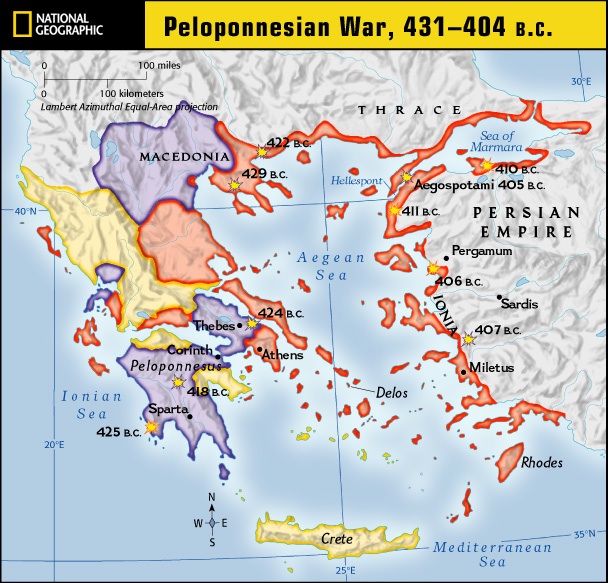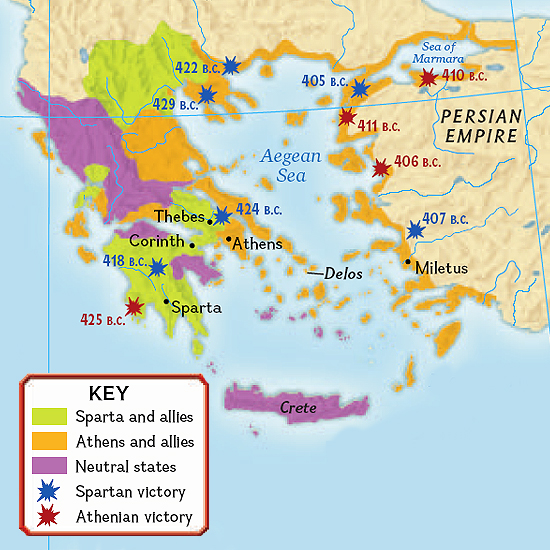
| ICE Case Studies
|
|
I.
Case Background |

Athens and Sparta led the coalition of Greek states that defeated Persian in the war that culminated in the victories of 479 bc. They continued to lead the alliance until the two dies, and their allies, went their separate ways in the fighting for power. The resulting conflict between the Athens and Sparta led alliances were known as the Peloponnesian Wars. These wars culminated victory of the Spartan Alliance in 431 BC.
The rivalry between Athens and Sparta continued for 50 years after the defeat of Persia. In 490 BC, the Persians launched their first invasion of Greece but were defeated at Marathon. In the second invasion, Xerxes was defeated at Thermopylae in 480 bc, and lost a key sea battle at the same time. The Greek forces defeated the Persians at Artemisium when he received news that the Persians had taken the pass at Thermopylae.
Thucydides, 431 BC, reported on the battle:
"The Peloponnesians now attacked their centre and drove ashore the ships of the Athenians, and
disembarked to follow up their victory. No help could be given to the centre either by the
squadron of Thrasybulus on the right, on account of the number of ships attacking him, or by
that of Thrasyllus on the left, from whom the point of Cynossema hid what was going on, and
who was also hindered by his Syracusan and other opponents, whose numbers were fully equal to his
own. At length, however, the Peloponnesians in the confidence of victory began to scatter in pursuit
of the ships of the enemy, and allowed a considerable part of their fleet to get into disorder."
the Athenians were victorius on the naval battlefield: "they took from the enemy eight Chian vessels, five Corinthian, two Ambraciot, two Boeotian, one Leucadian, Lacedaemonian, Syracusan, and Pellenian, losing fifteen of their own. After setting up a trophy upon Point Cynossema, securing the wrecks, and restoring to the enemy his dead under truce, they sent off a galley to Athens with the news of their victory. The arrival of this vessel with its unhoped-for good news, after the recent disasters of Euboea, and in the revolution at Athens, gave fresh courage to the Athenians, and caused them to believe that if they put their shoulders to the wheel their cause might yet prevail."
This account is from Thucydides, although the objectivity of his account is a matter of debate. "The Athenian Thucydides is the primary source of the wars, as he fought on the side of Athens. Thucydides was ostracized after the Spartans decisive victory at the Battle of Amphipolis in 422 BC, where Thucydides was one of the Athenian commanders. Thucydides wrote a book called The History of the Peloponnesian War. From 431 to 404 BC the conflict escalated into what is known as the "Great War." To the Greeks, the "Great War" was a world war, not only involving much of the Greek world, but also the Macedonians, Persians, and Sicilians."
The two alliances began with a league of nations allied against the Persians.
"Athens, along with about 150 other city-states, formed the Delian
League as a way to protect against a possible Persian invasion. If any one of the Delian
league members was attacked, the other league members would come to their support." In the
Second Peloponnesian War, however, these 150 city-states, along with many more form the
Spartan alliance, created a multi-polar system far beyond anything that exists today.
http://www.penfield.edu/webpages/jgiotto/onlinetextbook.cfm?subpage=1649849

Here is a look at the sides in the conflict.
http://orrinwoodwardblog.com/2012/11/24/peloponnesian-war-sparta-corinth-align-against-athens/

https://atheniandemocracy.weebly.com/the-peloponnesian-war.html
Image courtesy of www.williamette.edu.

A key resource in the course of the conflict was the role of tin. In the Bronze Age, tin and copper, the components of bronze, were high technology commodities. There were no copper resources in Greece and most import came from Germany and Central Europe. Tin, however, was found in a few places in Greece.
Control of tin mines thus became an important part of the war strategy. Tin was important for agriculture (making hoes and digging implements), industry (creating various tools), and military (for fashioning weapons).
Besides control of territory, control of tin resources was also a key aspect of the war.

A combination of land and sea warfare resulted in military casualties. Sieges however killed many more civilians. The Figure below shows some of the major conflict sites. Sieges of cities may have killed more. "In 430 BC, a plague struck the city of Athens, which was then under siege by Sparta during the Peloponnesian War (431-404 BC). In the next 3 years, most of the population was infected, and perhaps as many as 75,000 to 100,000 people, 25% of the city's population, died. The Athenian general and historian Thucydides left an eye-witness account of this plague and a detailed description to allow future generations to identify the disease should it break out again." (Littman)
Victories in Battles

Source:
http://tccl.rit.albany.edu/knilt/index.php/Lesson_3:_What_effect_did_the_Peloponnesian_War_have_on_the_Athenian_Empire%3F
There were atrocities that occurred on both sides during the Peloponnesian Wars. Before this time, battles were short affairs, lasting a matter of hours, and the losers treated with dignity. This was no longer the case.
Just after the start of the Peloponnesian War, in 430 BC, plague broke out in Athens, which killed nearly 1/3 of the population (Hale, 324).

This was a conflict that spaneed from Europe into Asia, as there were also numerous Greek states that were situated in Turkey. Sea warfare also includes battles in the immediate areas between the two states, but also also key areas in the eastern Mediterranean and Black Seas.
The Persians were defeated in the first Peloponnesian Wars. In the second war, of interest here, after many years, the Spartan alliance prevailed over Athens.

NATO
The Mayans and Environmental Conflict
30 Years War and the Holy Roman Empire
Go to Ice Search Engine and Scenario Builder
https://en.wikipedia.org/wiki/Battle_of_Thermopylae
Thucydides, THE HISTORY OF THE PELOPONNESIAN WAR, Translated by Richard Crawley, 431 BC.
R.J. Littman, "The plague of Athens: epidemiology and paleopathology",
US National Library of Medicine National Institutes of Health, Mt Sinai J Med. 2009 Oct;76(5):456-67. doi: 10.1002/msj.20137.
https://www.ncbi.nlm.nih.gov/pubmed/19787658
http://www.gutenberg.org/files/7142/7142-h/7142-h.htm >p>
